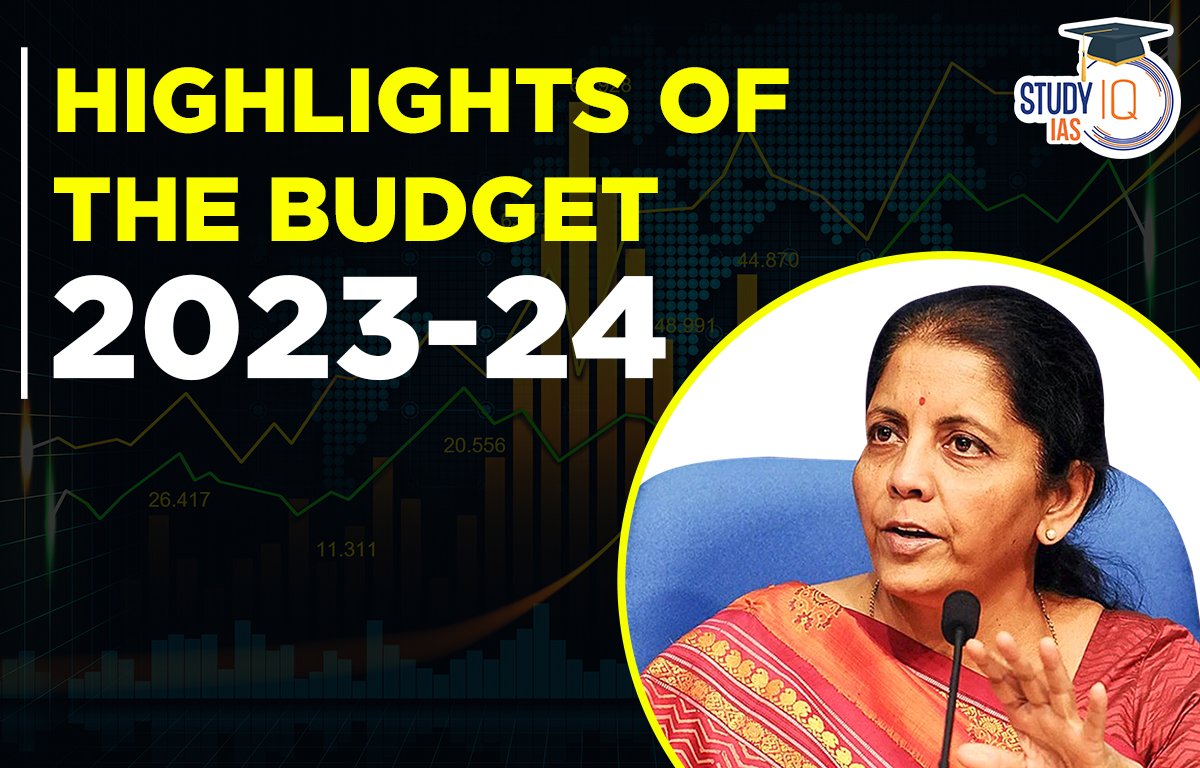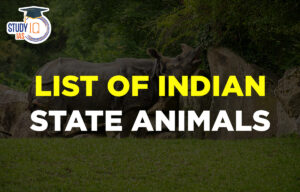Table of Contents
Context: Recently, Union Finance Minister Nirmala Sitharaman presented the Union Budget 2023 in Parliament.
- According to Article 112 of the Indian Constitution, the Union Budget of a year, also referred to as the Annual Financial Statement is a statement of the estimated receipts and expenditures of the government for that particular year.
Union Budget 2023 Highlights

- Budget 2023 is aimed at the economic empowerment of women and job generation for the youth.
- Per capita income has more than doubled to ₹1.97 lakh in around nine years.
- Indian economy has increased in size from being 10th to 5th largest in the world in the past nine years.
- Budget Estimates 2023-24: The total receipts other than borrowings is estimated at Rs 27.2 lakh crore and the total expenditure is estimated at Rs 45 lakh crore.
- The net tax receipts are estimated at Rs 23.3 lakh crore.
- The fiscal deficit is estimated to be 5.9 per cent of GDP.
- States will be allowed a fiscal deficit of 3.5 per cent of GSDP of which 0.5 per cent will be tied to power sector reforms.
- Fiscal deficit would be brought down to below 4.5% by 2025-26.
- Personal income tax: Change in the tax structure by reducing the number of
- tax slabs to 5 and increasing the tax exemption limit to ₹3 lakh.
- An increase in the income tax rebate limit from ₹5 lakh to ₹7 lakh.
- SAPTARISHI: Union Finance Minister listed seven key priorities of the Union Budget 2023, guiding the government through the Amrit Kaal. Seven priorities are:
- Inclusive development
- Reaching the last mile
- Infrastructure and investment
- Unleashing the potential
- Green growth
- Youth power
- Financial sector

Priority 1: Inclusive Development
Agriculture and Cooperation
- Digital Public infrastructure for agriculture will be built as an open source, open standard and interoperable public good.
- It will enable inclusive, farmer-centric solutions through relevant information services for crop planning and health, improved access to farm inputs, credit, and insurance, help for crop estimation, market intelligence, and support for the growth of the agri-tech industry and start-ups.
- Agriculture Accelerator Fund: It will be set up to encourage agri-startups by young entrepreneurs in rural areas, which will aim at bringing innovative and affordable solutions for challenges faced by farmers.
- Enhancing the productivity of cotton crops by adopting a cluster-based and value chain approach through Public Private Partnerships (PPP).
- Atmanirbhar Horticulture Clean Plant Programme: To boost the availability of disease-free, quality planting material for high-value horticultural crops at an outlay of Rs 2,200 crore.
- Global Hub for Millets ‘Shree Anna’: India is the largest producer and second largest exporter of ‘Shree Anna’ in the world as it grows several types of ‘Shree Anna’ such as jowar, ragi, bajra, kuttu, ramdana, kangni, kutki, kodo, cheena, and sama.
- Agriculture Credit: It will be increased to Rs 20 lakh crore with a focus on animal husbandry, dairy and fisheries.
- A new sub-scheme of PM Matsya Sampada Yojana will be launched with a targeted investment of Rs 6,000 crore to further enable activities of fishermen, fish vendors, and micro & small enterprises, improve value chain efficiencies and expand the market.
- Cooperation: Government will facilitate the setting up of a large number of multipurpose cooperative societies, primary fishery societies and dairy cooperative societies in uncovered panchayats and villages in the next 5 years.
Health, Education and Skilling
- Mission to eliminate Sickle Cell Anaemia by 2047 will be launched.
- 157 new nursing colleges will be established in co-location with the existing 157 medical colleges established since 2014.
- Joint public and Private Medical research to be encouraged via select ICMR labs for encouraging collaborative research and innovation.
- Teachers’ Training: It will be re-envisioned through innovative pedagogy, curriculum transaction, continuous professional development, dipstick surveys, and ICT implementation.
- District Institutes of Education and Training will be developed as vibrant institutes of excellence for it.
- National Digital Library for Children and Adolescents will be set-up for facilitating availability of quality books across geographies, languages, genres and levels, and device agnostic accessibility.
Priority 2: Reaching the Last Mile
Tribal Development
- Pradhan Mantri PVTG Development Mission: To improve socio-economic conditions of the particularly vulnerable tribal groups (PVTGs).
- Rs 15,000 crore will be made available in the next three years under the Development Action Plan for the Scheduled Tribes.
- Central Government will recruit 38,800 teachers and support staff for the 740 Eklavya Model Residential Schools, serving 3.5 lakh tribal students.
- Aspirational Districts and Blocks Programme covering 500 blocks for saturation of essential government services across multiple domains such as health, nutrition, education, agriculture, water resources, financial inclusion, skill development, and basic infrastructure.
Affordable Infrastructure
- PM Awas Yojana: Budget increased the allocation for the PM Awas Yojana (PMAY) by 66%.
- Scheme was launched in 2015 with the objective of providing affordable housing to all citizens.
- Aim: To assist the middle-income community, economically disadvantaged groups (EWS) and low-income groups (LIG).
- Urban Infrastructure Development Fund: It will be established through the use of priority sector lending shortfall.
- It will be managed by the National Housing Bank and will be used by public agencies to create urban infrastructure in Tier 2 and Tier 3 cities.
PM VIshwakarma KAushal Samman (PM VIKAS)
- Traditional artisans will get a package of assistance focusing on bettering the quality, scale and reach of their products.
- The package will include financial support, skill training, digital, green techniques, brand promotion, digital payment, social security etc.
Priority 3: Infrastructure & Investment
Infrastructure
- Investments in Infrastructure and productive capacity have being increased by 33 per cent to Rs 10 lakh crore, which would be 3.3 per cent of GDP.
- The ‘Effective Capital Expenditure’ of the Centre is budgeted at Rs 13.7 lakh crore, which will be 4.5 per cent of GDP.
- Railways: A capital outlay of Rs 2.40 lakh crore has been provided for the Railways, which is the highest ever outlay and about 9 times the outlay made in 2013- 14.
Support to State Governments for Capital Investment
- Government has decided to continue the 50-year interest free loan to state governments for one more year to spur investment in infrastructure and to incentivize them for complementary policy actions, with a significantly enhanced outlay of Rs 1.3 lakh crore.
Priority 4: Unleashing the Potential
Good Governance
- Jan Vishwas Bill: Government has introduced the Jan Vishwas Bill to amend 42 Central Acts.
- For enhancing ease of doing business, more than 39,000 compliances have been reduced and more than 3,400 legal provisions have been decriminalized.
- Centres of Excellence for Artificial Intelligence: Three centres of excellence for Artificial Intelligence will be set-up in top educational institutions, for realizing the vision of “Make A-I in India and Make A-I work for India”.
- National Data Governance Policy: To unleash innovation and research by start-ups and academia.
- An Entity DigiLocker will be set up for use by MSMEs, large business and charitable trusts for storing and sharing documents online securely.
Priority 5: Green Growth
Lifestyle for Environment
- To spur a movement of environmentally conscious lifestyle.
- India is moving forward firmly for the ‘panchamrit’ and net-zero carbon emission by 2070 to usher in green industrial and economic transition.
National Green Hydrogen Mission
- To facilitate transition of the economy to low carbon intensity, reduce dependence on fossil fuel imports, and make the country assume technology and market leadership in this sunrise sector.
- Target: To reach an annual production of 5 MMT by 2030.
MISHTI (Mangrove Initiative for Shoreline Habitats & Tangible Incomes)
- Aim: Intensive afforestation of coastal mangrove forests.
- To facilitate mangrove plantation along India’s coastline and on salt pan lands.
- It will operate through “convergence between MGNREGS, Campa Fund and other sources.
Gobardhan Scheme
- 500 new ‘waste to wealth’ plants under GOBARdhan (Galvanizing Organic Bio-Agro Resources Dhan) scheme will be established for promoting circular economy.
PM PRANAM (Prime Minister Programme for Restoration, Awareness, Nourishment and Amelioration of Mother Earth)
- To incentivise states and union territories promoting alternative fertilisers and the balanced use of chemical fertilisers.
- To reduce the use of chemical fertilisers in the country.
- To bring down the government’s subsidy burden, which is estimated to reach Rs 2.25 lakh crore in 2022-23: 39 per cent higher than last year’s figure of Rs 1.62 lakh crore.
Bhartiya Prakritik Kheti Bio-Input Resource Centres
- To further facilitate the adoption of “natural farming,”.
- 10,000 Bio-Input Resource Centres will be set-up, creating a national-level distributed micro-fertiliser and pesticide manufacturing network.
Amrit Dharohar
- It will be implemented over the next three years to encourage optimal use of wetlands, and enhance bio-diversity, carbon stock, eco-tourism opportunities and income generation for local communities.
- It will emphasise on the importance of wetlands and their preservation, with an outlook that is inclusive of local communities as caretakers of the ecosystem.
Priority 6: Youth Powerà To empower the youth and help the ‘Amrit Peedhi’ realize their dreams.
Pradhan Mantri Kaushal Vikas Yojana 4.0
- To skill lakhs of youth within the next three years.
- On-job training, industry partnership, and alignment of courses with needs of industry will be emphasized.
- It will cover new age courses for Industry 4.0 like coding, AI, robotics, mechatronics, IOT, 3D printing, drones, and soft skills.
Unity Mall
- States will be encouraged to set up a Unity Mall in their state capital or most prominent tourism centre or the financial capital for promotion and sale of their own ODOPs (one district, one product), GI products and other handicraft products, and for providing space for such products of all other States.
Priority 7: Financial Sector
Companies
- National Financial Information Registry: It will be set up to serve as the central repository of financial and ancillary information.
- It will facilitate efficient flow of credit, promote financial inclusion, and foster financial stability.
- Central Processing Centre: It will be setup for faster response to companies through centralized handling of various forms filed with field offices under the Companies Act.
MSME
- Credit Guarantee for MSMEs: It will enable additional collateral-free guaranteed credit of Rs 2 lakh crore.
Saving Scheme
- Mahila Samman Savings Certificate: It will offer deposit facility upto Rs 2 lakh in the name of women or girls for a tenor of 2 years at fixed interest rate of 7.5 per cent with partial withdrawal option.
- Senior Citizens: Maximum deposit limit for Senior Citizen Savings Scheme will be enhanced from Rs 15 lakh to Rs 30 lakh.
- Maximum deposit limit for Monthly Income Account Scheme will be enhanced from Rs 4.5 lakh to Rs 9 lakh for single account and from Rs 9 lakh to Rs 15 lakh for joint account.


 Daily Quiz 17 April 2025
Daily Quiz 17 April 2025
 Nilgiri Biosphere Reserve, Map, Climate,...
Nilgiri Biosphere Reserve, Map, Climate,...
 Complete List of Indian State Animals
Complete List of Indian State Animals





















